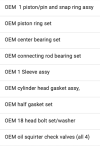A driving report and a cold-start follow-up question:
As I mentioned above, my confidence has been shaken after my ring experience with cylinder 4. Enough to where I went back to NE Auto Imports the week after I got the van back, to ask them to listen to it, and to make sure everything was as it should be, in their opinion (and considering all the costs)!
Specifically, it was starting up with a fair bit of diesel-smelling smoke still, and sounding rough when it started, whereas it had always started up rather smoothly, almost to where you couldn't tell it was a diesel. However, all my nice smooth starts were in the Bay Area, California, whereas now I was starting up at near (slightly to somewhat above) freezing temperatures.
And, once the van had warmed up, it started up just as usual after that for the rest of the day. Since I did recall some rough starts and smoke on our trip out west before the dreaded ring experience, when it was particularly cold out, I kind of figured it had to do with the cold temperatures. And that's what the folks at NE Auto Imports assured me of as well. They checked it out there too, and it's not losing oil at all, its fluid levels are all fine, and it sounds smooth once warmed up.
It's been hard to test starting up at warm temperatures, because we haven't really had them, although there was a day more in the 50s, but it would have followed a colder night. I still saw the smoke and heard the roughness, until it evened out after a few minutes once warm, and was fine for the rest of the day.
In order to break in Cylinder 4, we just took a trip (without our trailer) through Pennsylvania and New York, before coming back to Massachusetts. We drove almost 1750 miles (2800km) on this trip, as we ended up seeing neat things to do here and there! Every morning, the starts were the same. It does have new glow plugs now, and I realize these vans don't like cold, but I just want to make sure this is all expected before we leave New England, heading back to California (along a southerly route this time, we plan to take Route 66 most of the way, with the little trailer again)!
The video below captures the look and sound of our typical cold starts. I pump the pedal once before starting, then wait for the 6V glow plug click, then start it up. I guess I should have included that starting sound in the video, but the glow plug part is working great, and only on the coldest days has the van shut off moments after trying to stay running, and had to be restarted, and this only because it didn't seem to have enough warm fuel in its system yet (this also was typical of our coldest days before the ring issue).
So, for the start in the video, I pumped the pedal once, turned the key, and then continued to pump in more fuel with the pedal in order to bring up the RPMs to around 1000 once started (there's always some stuttering during this time, not included on the video). I then pulled the throttle knob out to hold RPMs at 1000 (after which the RPMs usually creep up to around 1250 during the course of the next minute or so). The video starts just after I've done all of this described.
In the video, there's a point in the middle-ish where the smoke definitely reduces in volume. That is the same moment that, seeing the RPMs to have crept up to 1250, and with the engine sounds evening out rather thank kind of stuttering, I then push the throttle knob back in, and let the van continue to idle up and warm up on its own from that point on.
My question is really whether this is just normal for near-to-somewhat-above-freezing cold starts? There were a few changes to the engine that I noticed after getting it back, the little vacuum hoses relating to the EGR were in a different configuration than when I brought it to NE Auto Imports. I did ask them about this too, and they looked at it and still saw the blanking and hoses as they should be, in their opinion. The engine was also missing what looked to be an insignificant tiny bracket in one spot. I asked them about this, and they confirmed its seeming relative insignificance. I was still a little surprised that it was returned without a piece, but it was in their shop for a long time in pieces, so I suppose these things can happen. I'll take a photo later of where that is, but it doesn't have anything to do with the cold starts, so it's not so relevant here.
Overall, the van performed great over our recent 1750 miles, getting 20.1 miles to the gallon, which is in line with its performance after the D4BF was originally put in (we had a fair few hills in third gear, which always impacts our mileage compared to interstate driving).
I will add, that there's just the tiniest puff of smoke when I start it (even when warm) these days, just barely anything, and maybe it always did that, I just don't think it did, but I'm probably just paranoid about it still, after everything we went through!




